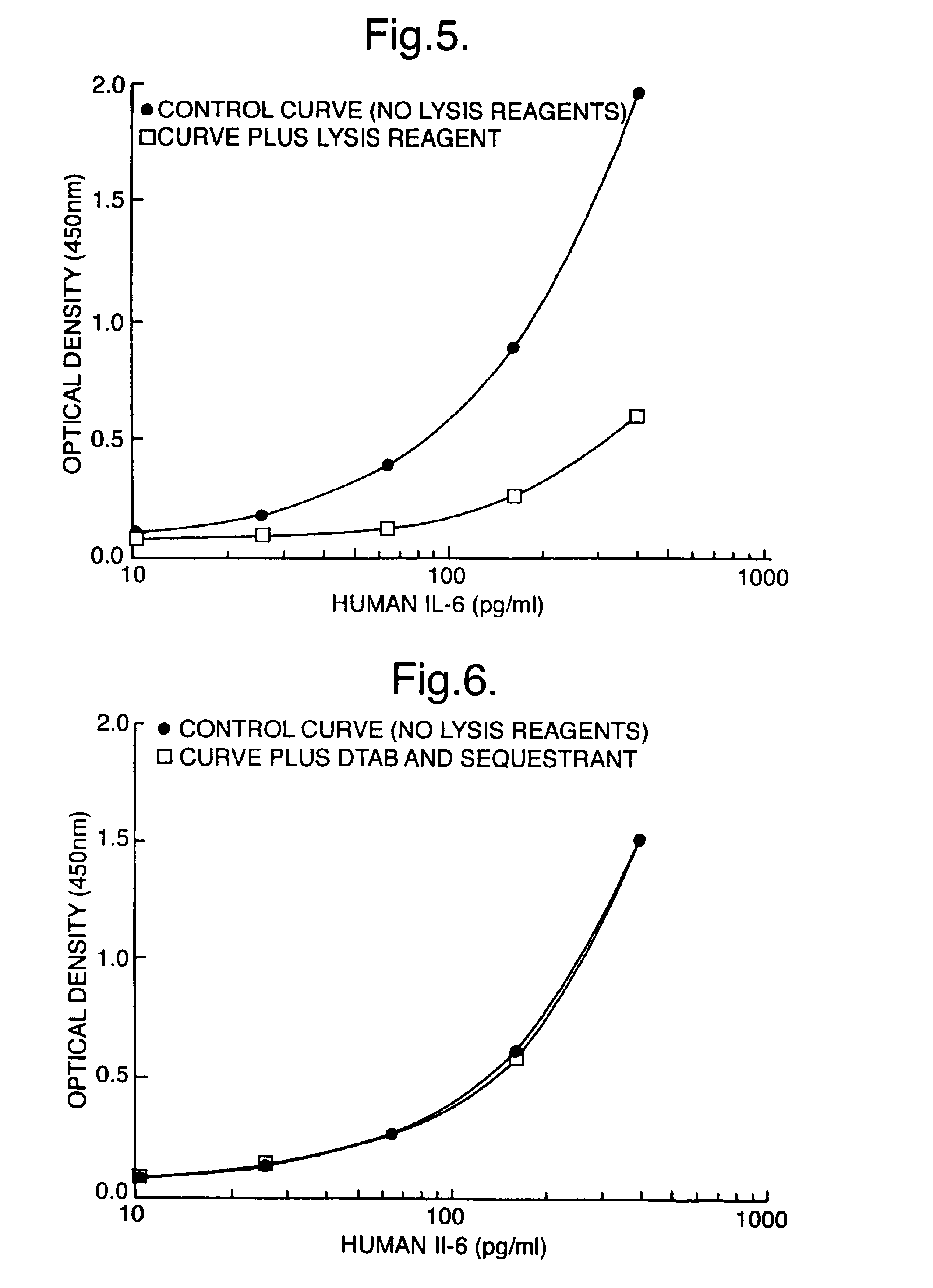In-situ cell extraction and assay method
a cell extraction and in-situ technology, applied in the field of immunoassays, can solve the problems of inability to process large numbers of cells samples, inability to reconstitute samples, inaccurate measurement or non-measurement of analyte in samples,
- Summary
- Abstract
- Description
- Claims
- Application Information
AI Technical Summary
Benefits of technology
Problems solved by technology
Method used
Image
Examples
examples
A. Preliminary Experiments
Scintillation Proximity Radioimmunoassay for Adenosine 3′5′ Cyclic Monophosphate
General Assay Conditions
[0080]Measurement of adenosine 3′5′cyclic monophosphate (cAMP) was selected as a model system for studying lysis and measurement of intracellular molecules. A number of potential extractants were selected from among various surfactants known to lyse and liberate contents from eukaryotic cells. These lysis reagents were used in a series of experiments in combination with sequestrating reagents in order to determine optimal reagents to be used. Standard curves for cAMP were prepared in lysis and sequestrating reagents. Parameters such as assay sensitivity, standard curve working range and antigen: antibody binding were used to establish the most suitable reagents and optimal concentrations for both lysis and sequestrating agent. Standard curves were prepared as follows.
[0081]All assays were carried out in microtitre plates compatible with a microtitre plate...
experiment 1
f Antigen and Antibody Binding by Several Lysis Reagents
Method
[0087]In these experiments, standard curves were prepared for cAMP using the SPA immunoassay technique, described above, where working standards of cAMP were prepared in several lysis reagents at 1% (w / v) or 2% (w / v) final concentration. The detergents investigated included dodecyl trimethyl ammonium bromide (DTAB; Sigma Chemical Co. D8638), benzethonium chloride (BZC; Aldrich; B470-8), cetyl pyridinium chloride (CPC; Sigma Chemical Co; C9002), sodium dodecyl sulphate (SDS, Sigma chemical Co; L4509) and N-dodecyl-N,N-dimethyl-3-ammonio-1-propanesulphonate (DDAPS; Sigma Chemical Co.; D4516).
Results
[0088]Table 3a). The effect of several lysis reagents on antibody:antigen binding (zero concentration of sequestrant). These data shown are counts per minute (cpm) obtained on a TopCount™ microplate scintillation counter. Efficiencies of other multihead beta counters vary is from this and may give different results. Non-specific ...
experiment 2
of Antigen and Antibody Binding with the Addition of Sequestrant (2.5% Alpha-Cyclodextrin).
Method
[0092]In these experiments, standard curves for cAMP were prepared using the SPA immunoassay technique described above, where working standards of cAMP were prepared in 1% (w / v), 1.5% (w / v) or 2% (w / v) lysis reagents (DTAB, SDS or CPC). The control consisted of no lysis reagent or cyclodextrin added. The effect including 2.5% (w / v) alpha-cyclodextrin (alpha-CD) (Sigma Chemical Co.; C4642) on antigen:antibody binding was investigated. Here, tracer, antisera and SPA beads were prepared in assay buffer containing 2.5% (w / v) alpha-CD. A second control tested the effect of 2.5% (w / v) alpha-CD on the standard curve without addition of lysis reagent.
Results
[0093]Table 4a). The effect of lysis reagent (1% DTAB) on antigen antibody binding with or without the addition of sequestrant. These data shown are counts per minute (cpm) obtained on a TopCount microplate scintillation counter. Efficiencies...
PUM
 Login to View More
Login to View More Abstract
Description
Claims
Application Information
 Login to View More
Login to View More - R&D
- Intellectual Property
- Life Sciences
- Materials
- Tech Scout
- Unparalleled Data Quality
- Higher Quality Content
- 60% Fewer Hallucinations
Browse by: Latest US Patents, China's latest patents, Technical Efficacy Thesaurus, Application Domain, Technology Topic, Popular Technical Reports.
© 2025 PatSnap. All rights reserved.Legal|Privacy policy|Modern Slavery Act Transparency Statement|Sitemap|About US| Contact US: help@patsnap.com



